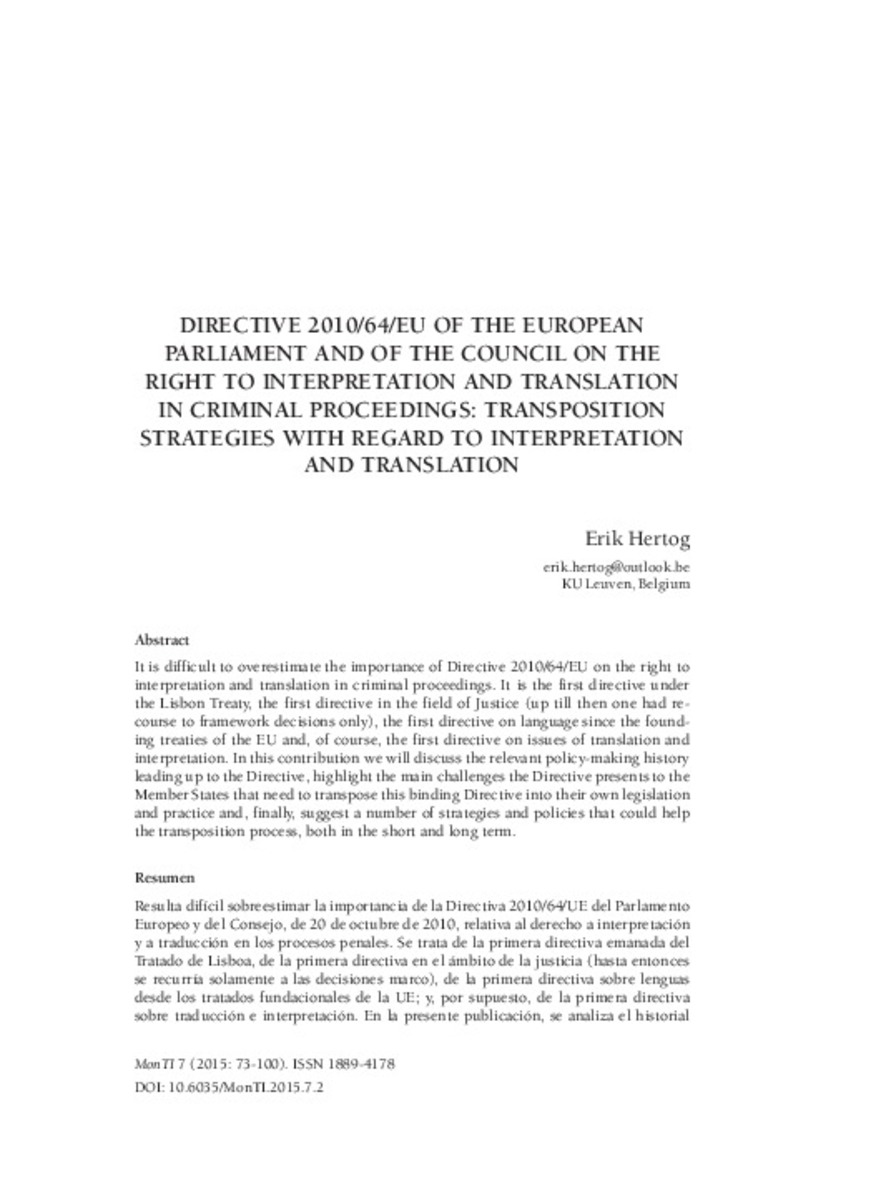Mostrar el registro sencillo del ítem
Directive 2010/64/EU of the European Parliament and of the Council on the Right to Interpretation and Translation in Criminal Proceedings: Transposition Strategies with regard to Interpretation and Translation.
| dc.contributor.author | Hertog, Erik | |
| dc.date.accessioned | 2016-02-09T12:42:27Z | |
| dc.date.available | 2016-02-09T12:42:27Z | |
| dc.date.issued | 2015 | |
| dc.identifier.issn | 1889-4178 | |
| dc.identifier.issn | 1989-9335 (electrònic) | |
| dc.identifier.uri | http://hdl.handle.net/10234/149270 | |
| dc.description.abstract | It is difficult to overestimate the importance of Directive 2010/64/EU on the right to interpretation and translation in criminal proceedings. It is the first directive under the Lisbon Treaty, the first directive in the field of Justice (up till then one had recourse to framework decisions only), the first directive on language since the founding treaties of the EU and, of course, the first directive on issues of translation and interpretation. In this contribution we will discuss the relevant policy-making history leading up to the Directive, highlight the main challenges the Directive presents to the Member States that need to transpose this binding Directive into their own legislation and practice and, finally, suggest a number of strategies and policies that could help the transposition process, both in the short and long term. | ca_CA |
| dc.description.abstract | Resulta difícil sobreestimar la importancia de la Directiva 2010/64/UE del Parlamento Europeo y del Consejo, de 20 de octubre de 2010, relativa al derecho a interpretación y a traducción en los procesos penales. Se trata de la primera directiva emanada del Tratado de Lisboa, de la primera directiva en el ámbito de la justicia (hasta entonces se recurría solamente a las decisiones marco), de la primera directiva sobre lenguas desde los tratados fundacionales de la UE; y, por supuesto, de la primera directiva sobre traducción e interpretación. En la presente publicación, se analiza el historial de decisiones políticas relevantes que han llevado a la aprobación de la Directiva, se destacan los principales retos que presenta la Directiva para los Estados Miembros que tienen que transponer esta norma de obligado cumplimiento a su propia legislación y ejercicio; y, finalmente, se sugieren una serie de estrategias y políticas que pueden ser útiles durante el proceso de transposición, tanto a corto como a largo plazo. | ca_CA |
| dc.format.extent | 28 p. | ca_CA |
| dc.format.mimetype | application/pdf | ca_CA |
| dc.language.iso | eng | ca_CA |
| dc.publisher | Universitat Jaume I | ca_CA |
| dc.publisher | Universitat de València | ca_CA |
| dc.publisher | Universitat d' Alacant | ca_CA |
| dc.relation.isPartOf | MonTI, 2015, núm. 7 p. 73-100 | ca_CA |
| dc.rights | © d’aquesta edició: Universitat d’Alacant, Universitat Jaume I, Universitat de València | ca_CA |
| dc.rights.uri | http://creativecommons.org/licenses/by/4.0/ | * |
| dc.subject | Directive | ca_CA |
| dc.subject | legal interpreting | ca_CA |
| dc.subject | legal translation | ca_CA |
| dc.subject | Directiva | ca_CA |
| dc.subject | interpretación judicial | ca_CA |
| dc.subject | traducción judicial | ca_CA |
| dc.title | Directive 2010/64/EU of the European Parliament and of the Council on the Right to Interpretation and Translation in Criminal Proceedings: Transposition Strategies with regard to Interpretation and Translation. | ca_CA |
| dc.type | info:eu-repo/semantics/article | ca_CA |
| dc.identifier.doi | http://dx.doi.org/10.6035/MonTI.2015.7.2 | |
| dc.rights.accessRights | info:eu-repo/semantics/openAccess | ca_CA |
| dc.relation.publisherVersion | http://hdl.handle.net/10045/52539 | ca_CA |
Ficheros en el ítem
Este ítem aparece en la(s) siguiente(s) colección(ones)
-
MonTi_ 2015 _núm 7 [14]








